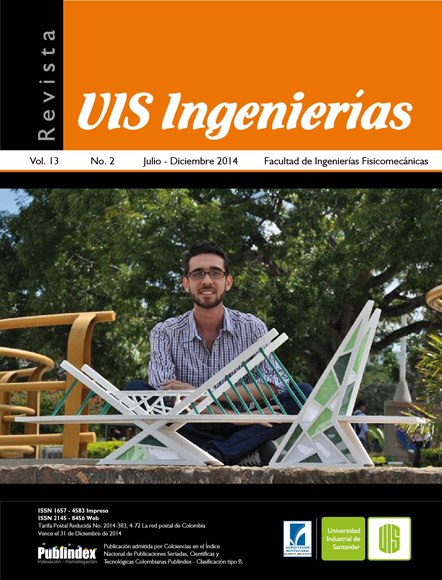Publicado 2014-06-15
Palabras clave
- Evaluación del potencial energético,
- energía solar,
- energía eólica,
- Bucaramanga
Cómo citar
Resumen
En este artículo se presenta un estudio estadístico del potencial solar y eólico en el campus central de la Universidad Industrial de Santander (UIS) y la ciudad de Bucaramanga, con el fn de obtener parámetros característicos que permitan evaluar el recurso energético en la zona. Para ello, se consideraron mediciones horarias de variables como radiación solar, temperatura ambiente, velocidad y dirección del viento para los años 2010, 2011 y 2012, en cuatro puntos estratégicos de la ciudad. Finalmente, se presenta un análisis sobre los resultados obtenidos y la viabilidad energética de implementar sistemas de generación fotovoltaica y eólica en las zonas de estudio.
Descargas
Referencias
- AHMED,A. S. Wind energy as a potential generation source at Ras Benas, Egypt. Renewable and Sustainable Energy Reviews, 14(8), 2167–2173. 2010. doi:10.1016/j.rser.2010.03.006
- AKDAG, S. A; DINLER, A. A new method to estimate Weibull parameters for wind energy applications. Energy Conversion and Management, 50(7), 1761– 1766. 2009. doi:10.1016/j.enconman.2009.03.020
- DAUT, I; IRWANTO, M; IRWAN, Y; M., GOMESH, N; AHMAD, N. S. Potential of Solar Radiation and Wind Speed for Photovoltaic and Wind Power Hybrid Generation in Perlis , Northern Malaysia, (June), 6–7. 2011.
- DUAN, W; CHEN, J; HENGCHANG, F. Comparative Research on Methods of Calculating Weibull Distribution Parameters of Wind Speed. In 2011 AsiaPacific Power and Energy Engineering Conference (pp. 1–4). 2011. IEEE. doi:10.1109/APPEEC.2011.5748608
- EL ALIMI, S; MAATALLAH, T; DAHMOUNI, A. W; BEN NASRALLAH, S. Modeling and investigation of the wind resource in the gulf of Tunis, Tunisia. Renewable and Sustainable Energy Reviews, 16(8), 5466–5478. 2012. doi:10.1016/j.rser.2012.05.004
- ELLIOTT, D. et al., Wind energy resource atlas of the United States. 1987.
- IGRAHIM, S. et al., Linear Regression Model in Estimating Solar Radiation in Perlis. Energy Procedia, 18, 1402–1412. 2012. doi:10.1016/j. egypro.2012.05.156
- ILINCA, A. et al., Wind potential assessment of Quebec Province. Renewable Energy, 28(12), 1881–1897. 2003. doi:10.1016/S0960-1481(03)00072-7
- KUMARASWAMY, B. G; KESHAVAN, B. K; JANGAMSHETTI, S. H. A statistical analysis of wind speed data in west central part of Karnataka based on Weibull distribution function. In 2009 IEEE Electrical Power & Energy Conference (EPEC) (pp. 1–4). 2009. IEEE. doi:10.1109/EPEC.2009.5420878
- KUMARASWAMY, G; KESHAVAN, K.; RAVIKIRAN, T. Analysis of seasonal wind speed and wind power density distribution in Aimangala wind form at Chitradurga Karnataka using two parameter weibull distribution function. In 2011 IEEE Power and Energy Society General Meeting (pp. 1–4). 2011. IEEE. doi:10.1109/PES.2011.6039587
- LAZAR, R., & EDER, J. Estudio sobre el clima urbano en Bucaramanga. Universidad Industrial de Santander, UIS. 2001.
- OSMA, A. Proyecto de investigación de maestría: Uso racional de la energía a partir del diseño de aplicaciones sostenibles en el Edificio Eléctrica II de la Universidad Industrial de Santander. 2011. Universidad Industrial de Santander. Dirigido por el Dr. Gabriel Ordóñez Plata.
- OSMA, A; ORDÓÑEZ, G. Design of a photovoltaicwind power generation system with grid connection and two micro-grids. In 2012 IEEE International Symposium on Alternative Energies and Energy Quality (SIFAE) (pp. 1–6). 2012. Barranquilla: IEEE. doi:10.1109/SIFAE.2012.6478886
- OUAMMI, A. Monthly and seasonal assessment of wind energy characteristics at four monitored locations in Liguria region (Italy). Renewable and Sustainable Energy Reviews, 14(7), 1959–1968. 2010. doi:10.1016/j.rser.2010.04.015
- REY, J. Analysis of the Inclusion of Smart Grids Technology in the Colombian Electric Power System. In 2013 International Symposium on Power Quality, SICEL. 2013. Medellin, Colombia.
- RODRIGUEZ, H. Plan de desarrollo para la fuentes no convencionales de energía en Colombia Vol 3: Tecnología y Costos. 2010. Bogotá, Colombia.
- RODRIGUEZ, H. et al., Plan de desarrollo para las fuentes no convencionales de energía en Colombia Vol 2: Diagnosticos de las FNCE. 2010. Bogotá, Colombia.
- UCAR, A; BALO, F. Assessment of wind power potential for turbine installation in coastal areas of Turkey. Renewable and Sustainable Energy Reviews, 14(7), 1901–1912. 2010. doi:10.1016/j.rser.2010.03.021
- UPME-IDEAM. Atlas de Radiación Solar de Colombia. Bogotá, Colombia, Colombia: Ministerio de Minas y Energia. Unidad de Planeación Minero Energetica (UPME) y Ministerio de Ambiente y Desarrollo Territorial- Instituto de Hidrología Meteorología y Estudios Ambientales (IDEAM). 2005.
- ZHAO, M; LIU, Z; YU, M. Testing and analyzing of solar energy resource assessment in inner mongolia. In 2009 4th IEEE Conference on Industrial Electronics and Applications, 2009, (pp. 2177–2179). IEEE. doi:10.1109/ICIEA.2009.5138583

